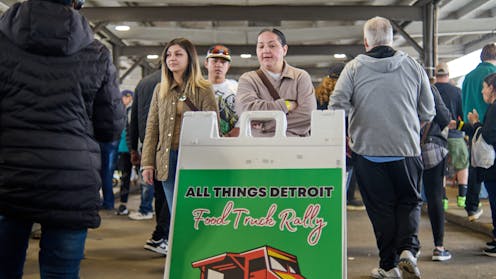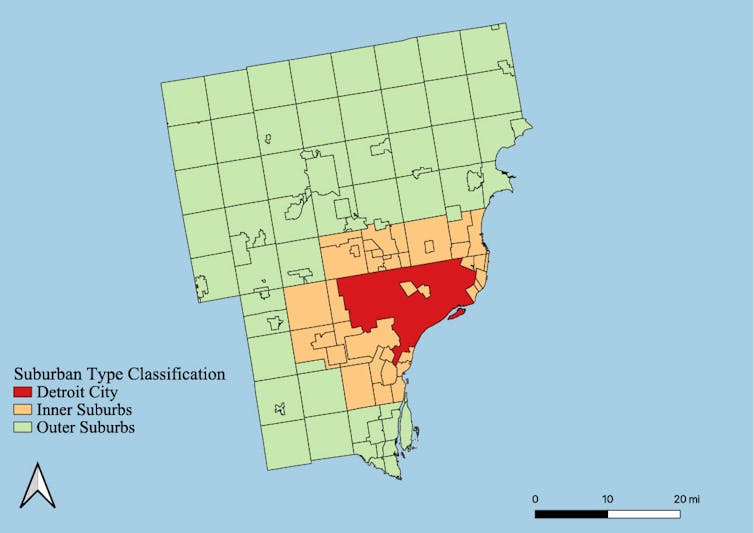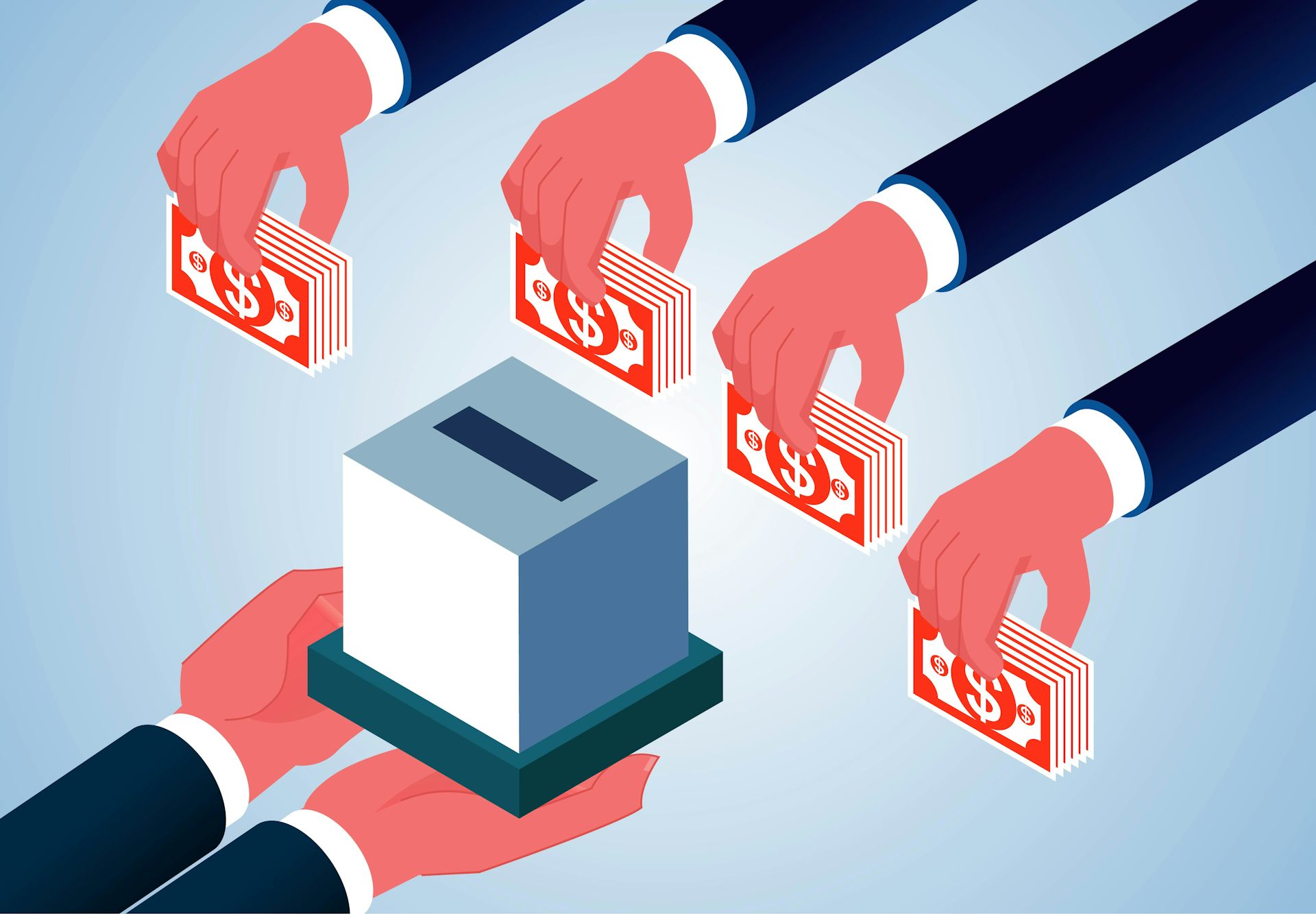Metro Detroit is growing – but its suburbs are telling a more complicated story
The outer ring of suburbs is attracting more new residents − and they are richer and better educated.

Following decades of population loss, Detroit may finally be turning a corner.
According to the U.S. Census Bureau’s most recent estimates, the city saw an increase in population for both 2023 and 2024.
An additional 11,000 people moved into the city in the years 2023 and 2024, a small gain in a city with a population of 645,705 – but one which marked a symbolic shift.
The census data shows just over 1% growth in the past year alone and 0.7% the year before compared with a nearly 25% loss between 2000 and 2010.
As an urban sociologist studying issues related to race and ethnicity, I am interested in how Detroit’s population is changing, and where different groups live in both the city and its suburbs.
Analyzing population trends in the metro Detroit area using data from the U.S. Census Bureau, I wanted to understand how racial, ethnic and socioeconomic trends are unfolding, and what those changes can tell us about the evolution and vitality of Detroit.
Black Detroiters relocate, city diversifies
From 2010 to 2023, Detroit’s racial and ethnic makeup continued to gradually diversify even as the city was declining in population.
While Black residents are still the majority, their proportion of the total number fell from around 84% to 79%.
Other groups, in contrast, increased their share of the city’s population. Between 2010 and 2023, the percentage of Hispanic residents grew from 6.6% to 8.3%, the percentage of white residents grew from 8.2% to 10.7%, and the percentage of Asian residents grew from 1.3% to 1.7%.
These shifts reflect a steady and ongoing diversification of Detroit’s population, indicative of new migration trends and shifting neighborhood dynamics.
Suburbs in flux
In addition to Detroit’s recent population growth, a broader story is unfolding in the city’s suburbs.
The population of the suburban area as a whole increased 0.73% from 2023 to 2024, but growth was not evenly spread. Collectively, the outer-ring suburbs gained almost 20,000 people, increasing by 1%. Communities such as the city of Troy and Macomb Township accounted for a significant share of that growth.

Inner-ring suburbs, such as Southfield, Warren and others, grew less vigorously – gaining just 4,000 people, or 0.31%.
These differences highlight the necessity of complicating the conventional city-versus-suburb narrative to acknowledge the many economic and racial divisions across the metropolitan region.
The socioeconomic statuses of residents of the inner- and outer-ring suburbs diverged between 2000 and 2020.
My analysis of census data shows that although both subregions witnessed increases in median household incomes, the rates of change were significantly higher in the outer-ring suburbs, with a 37.7% increase versus a 16.8% increase in the inner rings.
The data shows a similar trend in higher education attainment. Outer ring suburbs gained 7.1% more residents with college degrees or higher during this period, while the inner suburbs lost 7.5%.
Homeownership patterns in the two suburban regions also diverged over those two decades, increasing 18% in the outer rings and decreasing 10% in the inner rings.
The data on poverty and immigration also reveal contrasting results.
According to my calculations of census data, inner-ring suburbs experienced a 77% increase in poverty, while the outer ring experienced a lesser, though considerable, 50.8% bump in poverty during the 2000-2020 period.
Meanwhile, during the same time period, the foreign-born populations in the outer suburbs expanded by 24.9%, with increases of at least 10,000 in places such as Sterling Heights, Novi and Canton. In contrast, the inner suburbs saw more modest gains — around 5,000 in cities such as Dearborn Heights and Warren — while their overall foreign-born share declined by nearly 20%.
Together, the above trends highlight the necessity of not viewing the suburban area as a monolith. These patterns reflect national trends, in which many older, inner-ring suburbs are experiencing socioeconomic stagnation or decline while newer, outer-ring suburbs continue to attract more people who have higher incomes.
Mixed neighborhoods grow
Residential segregation also differentiates inner and outer suburban rings.
Segregation levels remain high in the inner suburbs, especially between white and Black residents. While outer suburbs tend to be more integrated today, the rate of change there has been more modest over the past two decades.
Social scientists measure segregation using a tool called the “dissimilarity index.” The index represents the proportion of one group that would need to move to establish an equal distribution of the population based on their relative numbers. It ranges from 0 to 100. A score of 0 means equal distribution across neighborhoods, while a score of 100 means the two groups live in completely separate areas.
From 2000 to 2020, white-Black segregation across the region decreased from 84.4% to 68.3% on the index, while white-Hispanic segregation decreased from 47.6% to 39.9%. Together, these numbers indicate a broader trend toward more integrated living patterns.
In the inner-ring suburbs, segregation fell across the board. White-Black segregation went down by 15.6%; white-Asian and white-Hispanic segregation dropped even more, by 43.2% and 30.7%, respectively.
These trends suggest that while the outer suburbs currently have lower levels of segregation, the inner suburbs are integrating more rapidly, reflecting shifting patterns of neighborhood change and increasing racial and ethnic diversity.
Detroit has come a long way since exiting bankruptcy in 2014. Its recent population growth and increasing diversity show important signs of renewal.
Grigoris Argeros does not work for, consult, own shares in or receive funding from any company or organization that would benefit from this article, and has disclosed no relevant affiliations beyond their academic appointment.
Read These Next
The Bible says little about Jesus’ childhood – but that didn’t stop medieval Christians from enjoyin
Legends about Jesus’ early years that circulated in medieval Europe often drew on apocryphal texts.
Whether Netflix or Paramount buys Warner Bros., entertainment oligopolies are back – bigger and mor
Hollywood has seen this movie before.
Can scientists detect life without knowing what it looks like? Research using machine learning offer
A new machine learning model explores the boundary between biological and nonbiological chemistry.






